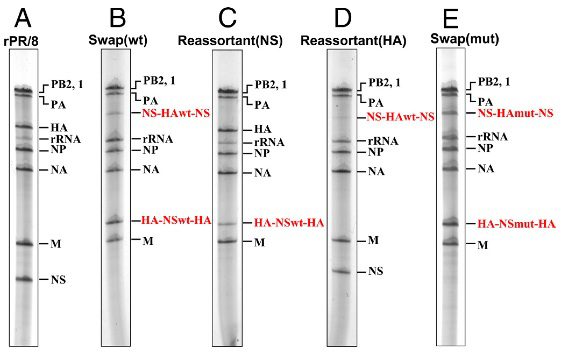

The process of influenza virus replication includes the incorporation of eight viral RNAs into each newly synthesized virion. This process, called packaging, depends upon specific RNA sequences in each genome segment. By swapping the packaging sequences for the nonstructural protein (NS) and HA genes, a virus was produced which replicated but lost the ability to independently reassort the HA or NS gene. The authors note that the other influenza A virus RNA segments could be modified in a similar way to reduce or eliminate their ability to form reassortant viruses.
Some have speculated that replacement of all the influenza viruses on the globe with reassortment-defective influenza viruses would eliminate pandemics. Reassortment is a major driver of influenza virus evolution, and the mechanism by which pandemic strains arise. In a world full of reassortment-defective influenza viruses, antigenic drift would still occur, which means that seasonal influenza would not be eliminated. But that could probably be accepted in exchange for eliminating the ability, for example, of H5N1 viruses to reassort with human strains.
Unfortunately, this scenario is highly improbable. Influenza viruses infect so many animal species that it would be virtually impossible to replace all viruses with a reassortment-defective strain. To predominate, this strain would require a strong selective advantage over wild strains, an unlikely scenario. The fact that the strain is engineered by humans virtually guarantees that it will be less fit than wild viruses, and hence unable to replace them.
Even in the unlikely event that we could devise ways to replace all the influenza virus strains in the world with one that cannot undergo reassortment, it is unlikely that this phenotype would endure. Influenza viruses, like all RNA viruses, undergo high mutation rates as a consequence of error-prone RNA replication. Long before the laboratory-engineered strain circled the globe, mutations would likely occur that restore its ability to undergo reassortment.
There is at least one practical use for a reassortment-defective influenza virus. The infectious, attenuated influenza virus vaccines currently in use could in theory reassort with circulating wild type viruses, leading to the the production of a pathogenic strain. This possibility would be reduced if the attenuated vaccines were engineered so they could not undergo reassortment.
[Technical note: As shown in the figure, influenza reassortment was examined by gel electrophoresis, not PCR. The approach is similar to my method from 1979, with the exception that viral RNAs are detected by silver staining, not autoradiography.]
Gao, Q., & Palese, P. (2009). Rewiring the RNAs of influenza virus to prevent reassortment Proceedings of the National Academy of Sciences DOI: 10.1073/pnas.0908897106

if influenza would reassort as much a in birds, shouldn't it become
as mild as it is in birds too ?
Flu is trying to spread better but this seems to coincide with
less virulence.
So, here is another idea: create new flu-viruses by enhanced artificial
evolution including artificial recombination and enhanced mixing (reassortment)
of different strains in some closed environment (swine ?)
try to produce viruses which spread better in the wild and are less virulent
so to out-compete existing strains (which aren't capable of that enhanced
mixing)
Hi Vincent
Thank you for the very interesting article. I have two questions for you regarding swine flue.
1) Vaccination: the authorities in Europe are already starting vaccinating pregnant women. Is the vaccine reliable? do you think enough tests have been done? (I read that in case of pandemy the approval process, given the emergency, takes much less time. ie in Denmark only 120 pregnant women have been tested….). Given the current situation, would you reccomand the vaccination to your wife if pregnant?
2) The virus is supposed to be very contagious far more than than the “normal” one. That said why just few hundred thousand cases came out in Europe and in the US? also in countries hit hard during the fall as Argentina, only 1 ml people got infected (less than 5% of the population). If math is not an opinion something does not fit statistically here.
Thank you for your attention and for the very good blog. Ciak
Pingback: MicrobiologyBytes » Blog Archive » Rewiring influenza
Gell electrophoresis of segmented viruses (ROBA) the appearence of segments on gell, do they correlate to the number of viral segments? ex. Reovirus 12 seg Orthomyxo 10
Yes, you can visualize all the viral RNA segments by gel
electrophoresis. Occasionally two segments may co-migrate but they can
be separated using different running conditions.
Gell electrophoresis of segmented viruses (ROBA) the appearence of segments on gell, do they correlate to the number of viral segments? ex. Reovirus 12 seg Orthomyxo 10
Yes, you can visualize all the viral RNA segments by gel
electrophoresis. Occasionally two segments may co-migrate but they can
be separated using different running conditions.